I’ve seen hundreds of businesses start with passion but fail because of simple, preventable mistakes—and coaching is no different.
This guide shares 10 common mistakes new coaches often make and how avoiding them can save you time, stress, and money while helping you build a business that lasts.
Many coaches begin with big dreams and lots of energy, but overlook the need for structure. Without a clear plan, fair pricing, or a defined niche, progress slows down.
Success comes not just from what you do, but from avoiding the wrong steps. Skipping these mistakes sets you up for steady growth.
10 Mistakes to Avoid While Starting a Coaching Business
Your passion can start the journey, but it won’t carry your coaching business on its own. The choices you make at the beginning—how you plan, price, market, and set up systems—decide if you grow with confidence or face constant setbacks. In the steps below, we’ll look at the most common mistakes new coaches make and how to avoid them.
Starting Without a Simple Plan
Many new coaches start their business full of passion but without a clear plan. At first, it feels exciting—you make a website, reach out to contacts, and hope clients come in. But soon, decisions pile up and attention drifts. Should you cut prices? Try ads? Add more services? Without a plan, everything feels urgent, and growth slows.
Here’s an example of how a simple one-page plan might look in real life—clear, short, and easy to follow.
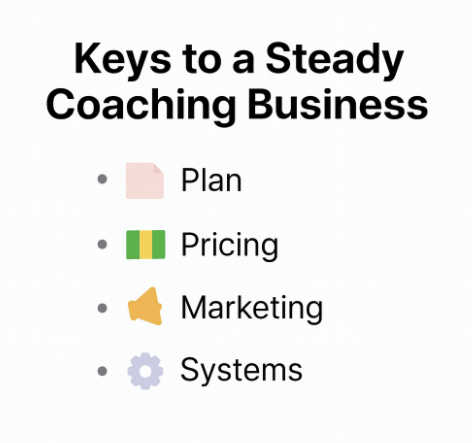
If you want a faster way to set this up, you can use an AI Business Plan Creator to structure your vision, niche, and finances in under an hour.
Not Defining a Niche
If your audience is “anyone,” your message fits no one. A clear niche helps you stand out, show value, and get referrals faster. Without it, your message sounds vague, and leaders won’t know if you are the right coach for them.
Niche Options and Examples:
| Niche Option | Ideal Client Example | Primary Outcome |
| Executive Coaching | VP or Director leading larger teams | Broader leadership capacity |
| Career Coaching | Mid-career manager seeking promotion | Clear path and offer-ready toolkit |
| Wellness Coaching | High performers battling burnout | Energy, routines, and resilience |
| Leadership Coaching
|
New managers in growing companies | People, leadership, and influence |
Customer Persona Example:
Meet Sarah, a mid-career manager aiming for promotion. She feels stuck, wants clarity on next steps, and needs tools to show leadership potential. A career coaching package with clear outcomes helps her move forward with confidence.
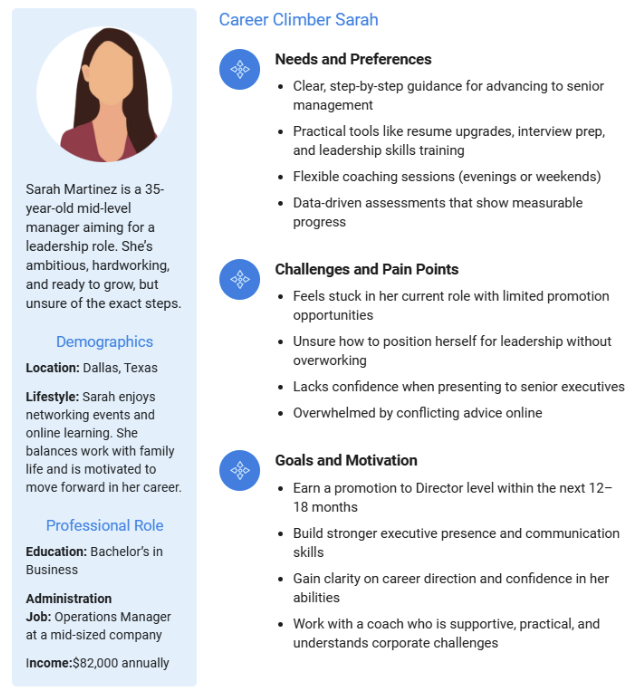
Undervaluing Services with Low Pricing
Coaching is powerful, but it’s also broad. If you don’t define your niche, your message gets lost in the noise. Picking a niche is one of the first big choices that gives your business clarity and direction.
Start by asking: Who do I want to serve, and what are their main challenges?
For example, you might choose executive coaching for senior leaders preparing for bigger roles, or career coaching for mid-level managers aiming for promotion. That becomes your niche.
To get more specific, think about:
- Are they new managers, mid-career professionals, or entrepreneurs?
- What goals matter most to them—career growth, balance, or resilience?
- What struggles do they face daily that your coaching can solve?
Neglecting Professional Branding
Your brand is often the first impression people get of your coaching business, and it can decide whether they trust you or not. You don’t need a fancy logo or expensive design work, but you do need a professional and consistent presence across platforms.
A simple website that clearly shows your promise, services, and contact details builds instant credibility. An updated LinkedIn profile with a clean photo and a headline focused on results makes you look reliable and approachable. Sharing even one clear case study or testimonial helps prove the real outcomes you deliver.
On the other hand, many coaches weaken their brand by offering too many services without clarity, using vague language that doesn’t show proof, or relying on visuals that confuse rather than support their message.
Overlooking Assessments and Tools
Trusting only your gut can reduce your impact as a coach. Intuition helps, but leaders often want solid proof before they commit to change. Using trusted assessments makes progress easier to explain, measure, and repeat.
The Leadership Circle Profile® 360° is a powerful tool for this. It shows a leader’s strengths, weak points, and areas for growth in a clear way. With these results, both coach and client use the same language to set goals and check progress over time.
Key Benefits:
- Gives leaders clear, data-based insights they understand.
- Creates a baseline to track growth and results.
- Helps you stand out when offering services to companies.
Keep it simple for clients by adding a page to your website that explains your assessment process and shows exactly what they will get.
Ignoring Marketing and Client Acquisition
Relying only on word of mouth can hold your business back. To grow, every coach needs simple and steady ways for new clients to find them. Marketing does not need to be complex, but it must be consistent.
- LinkedIn: One practical post per week, one short story per month
- Referrals: Ask every happy client for one intro to a peer or HR lead
- Quarterly webinar on a leader’s pain point
- Guest spot on one relevant podcast
- Short PDF checklist offered on your site
By using even two of these steps, you create steady visibility and trust. Focus on rhythm, not reach. Small, regular actions work better than random big pushes. To add weight, use data such as the ICF Global Coaching Study. Leaders respond well when advice is backed by evidence.
Skipping Financial Planning
Financial planning is a key part of building a stable coaching business. Without it, income feels unpredictable, and expenses can get out of control. A simple plan makes your numbers clear and gives you confidence to make decisions.
Before looking at the key elements, here’s an example of a simple 12-month forecast. It shows how tracking revenue month by month can turn uncertainty into steady growth.
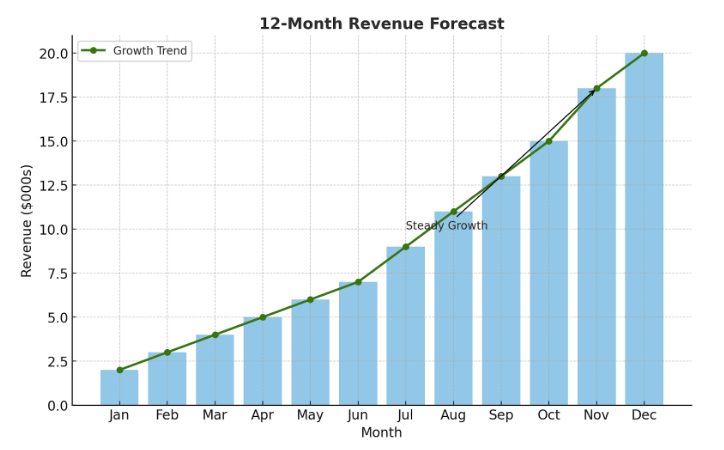
- One-time costs: website, legal setup, certification fees
- Monthly costs: software, marketing, supervision
- Revenue: packages sold per month and average fee
- Cushion: three months of expenses, if possible
Working with a business plan expert can help you set up clear financial models that grow with your business.
These models don’t just track money—they give you confidence, make decisions easier, and show clients that you are professional and reliable.
Working Alone Without Mentorship
Solo can be slow. Feedback shortens the path and opens doors. Join a peer circle or supervision group. Seek one mentor who has built the kind of practice you want. Consider becoming a Leadership Circle Certified Practitioner to access training, a practitioner community, and recognized tools.
Here are a few simple steps to consider:
- Monthly mentor call with two questions: “What did I learn? What will I change?”
- Quarterly peer case reviews focused on outcomes and ethics
- Annual learning plan tied to your niche
Support prevents drift and keeps you improving.
Weak Operational Systems
Running a coaching business isn’t just about great sessions—it’s also about smooth systems in the background. If your operations are messy, clients may feel confused and you’ll waste energy on admin instead of coaching.
Core Areas to Cover
| Area | Purpose | Tool Examples |
| Scheduling & Payments | Allow clients to book easily and pay on time | Calendly, Acuity, Stripe |
| Contracts & Policies | Set clear expectations and protect both sides | E-signature templates (e.g., DocuSign) |
| Client Records | Keep track of goals, notes, and progress | Coaching CRMs, Notion, spreadsheets |
| Session Delivery | Ensure calls run smoothly and can be recorded | Zoom, Google Meet, Teams |
A consistent system not only saves your time but also signals professionalism. Clients see that you are organized, reliable, and serious about helping them succeed.
Not Measuring Progress
If you don’t track progress, you won’t know what’s working. If you don’t measure, you guess. Measure enough to learn, not so much that it feels heavy. Small checks done often can guide steady improvement.
Five Key Signals to Track
- New clients per month and per quarter
- Renewal or continuation rate after the first package
- Revenue trend and average package value
- Client satisfaction from a one-minute pulse survey
- Check your wellbeing score each week on a 1–5 scale.
The chart below shows how simple numbers like new clients, revenue, and satisfaction can be tracked to give a clear view of business health.
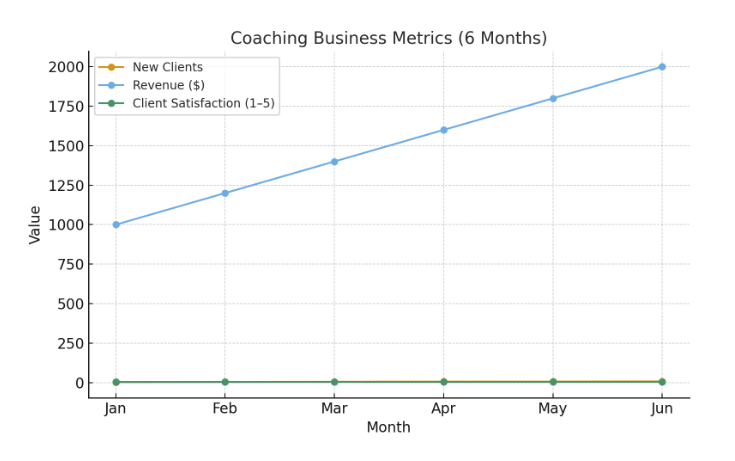
Final Thoughts
Starting a coaching business does not mean doing it all at once. It means taking small steps at the right time. When you avoid mistakes, you cut stress and build a business that feels steady and rewarding.
See your business as a journey. Each step—like setting prices, choosing a niche, or using simple systems—adds stability. Over time, these steps shape a coaching practice that leaders trust.
Ask yourself: which step matters most today? Write it down. Take action and let it guide your next move.
Progress comes from steady work, not rushing.
To explore leadership growth, meet with a Leadership Circle consultant today. We can provide countless tools and resources used by global organizations.
Kamal Patel is a guest contributor to the Leadership Circle blog.
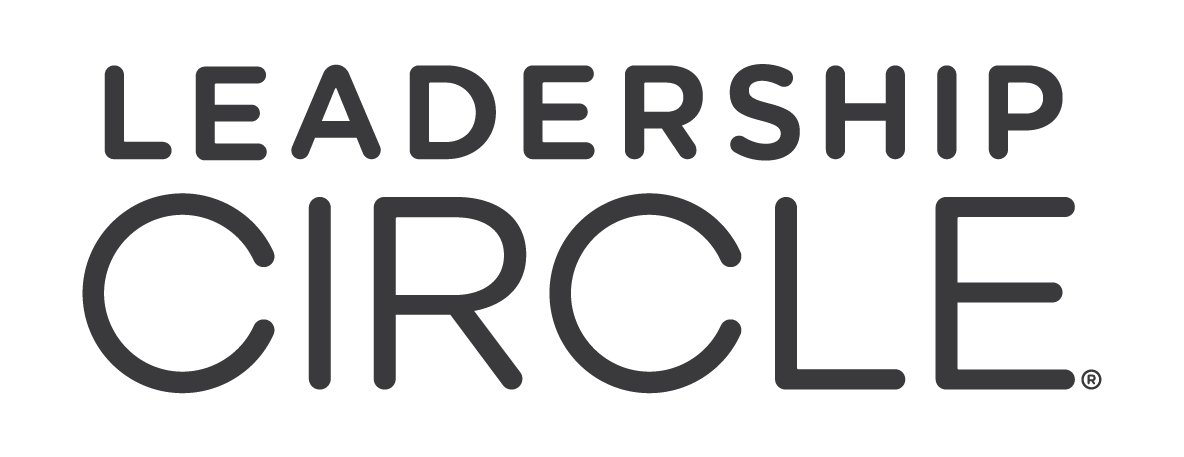





This is such a timely reminder that passion alone isn’t enough to sustain a coaching business. I’ve seen many new coaches skip over defining their niche or structuring their pricing strategy, which quickly leads to burnout and confusion. Your point about building systems early on really resonates—it’s the foundation that lets creativity and coaching skills actually thrive.
Your blog is a constant source of inspiration for me. Your passion for your subject matter shines through in every post, and it’s clear that you genuinely care about making a positive impact on your readers.
Your blog is a treasure trove of knowledge! I’m constantly amazed by the depth of your insights and the clarity of your writing. Keep up the phenomenal work!
Your blog is a treasure trove of valuable insights and thought-provoking commentary. Your dedication to your craft is evident in every word you write. Keep up the fantastic work!
I didn’t realize the impact of pricing strategy until reading this. It’s definitely something I’ll focus on now.
Your blog is a true hidden gem on the internet. Your thoughtful analysis and engaging writing style set you apart from the crowd. Keep up the excellent work!
Your blog is a treasure trove of valuable insights and thought-provoking commentary. Your dedication to your craft is evident in every word you write. Keep up the fantastic work!